Exploring the African Countries on the Shores of Lake Tanganyika
Lake Tanganyika, the longest freshwater lake in the world and the second deepest, cradles several African countries along its shores. These nations, each with a unique history and culture, are inextricably linked to the lake’s resources and beauty. This article delves into the fascinating tapestry of these countries, exploring their connection to Lake Tanganyika.
Unveiling the Nations Gracing Lake Tanganyika’s Shores
Four countries share the majestic coastline of Lake Tanganyika: Burundi, Tanzania, the Democratic Republic of Congo (DRC), and Zambia. Each country benefits from the lake’s rich resources, which contribute significantly to their economies and livelihoods. Fishing provides sustenance and income, while the lake itself serves as a crucial transportation route. The stunning natural beauty of the region also draws tourism, further boosting local economies.
Burundi: A Nation Embraced by the Lake
Burundi, a small, densely populated country, relies heavily on Lake Tanganyika. The lake provides essential protein for the population through fishing, and its shores are dotted with bustling fishing communities. These communities are deeply intertwined with the lake’s rhythms, their daily lives dictated by the ebb and flow of its waters.
The fertile lands surrounding Lake Tanganyika in Burundi are also used for agriculture, contributing significantly to the country’s food security.
Tanzania: A Blend of Nature and Culture
Tanzania boasts a substantial portion of Lake Tanganyika’s shoreline. Tourism plays a significant role in the Tanzanian economy, with the lake attracting visitors from across the globe. The pristine beaches, crystal-clear waters, and diverse wildlife found in the surrounding national parks, such as Gombe National Park, create a truly unique experience for nature lovers.
The lake also plays a crucial role in transport and trade for Tanzania, facilitating the movement of goods and people between different parts of the country and neighboring regions.
The Democratic Republic of Congo: A Rich Tapestry of Life
The DRC, with its vast and diverse landscape, shares the largest portion of Lake Tanganyika’s coastline. Like its neighbors, the DRC benefits from the lake’s resources, including fishing, transportation, and the potential for hydroelectric power generation. However, the country also faces challenges in sustainably managing these resources and ensuring equitable access for all communities.
The DRC’s section of Lake Tanganyika supports a diverse ecosystem, including various fish species and other aquatic life.
Zambia: A Gateway to the Lake’s Southern Reaches
Zambia occupies the southernmost tip of Lake Tanganyika, offering unique access to this remarkable body of water. The lake provides a valuable source of freshwater and supports local fisheries, contributing to the livelihoods of communities in the region.
Tourism also plays a growing role in Zambia’s relationship with Lake Tanganyika, with visitors drawn to the unique beauty of the lake’s southern shores.
Which African Country is on the Shores of Lake Tanganyika?
As we’ve seen, four African countries grace the shores of Lake Tanganyika: Burundi, Tanzania, the Democratic Republic of Congo (DRC), and Zambia. Each of these countries has a unique relationship with the lake, benefiting from its resources and grappling with the challenges of sustainable development.
Conclusion
Lake Tanganyika, a jewel of East Africa, serves as a vital lifeline for the countries nestled along its shores. From Burundi to Zambia, the lake supports livelihoods, drives economies, and offers breathtaking natural beauty. Understanding the interconnectedness of these countries with Lake Tanganyika is crucial for promoting sustainable development and ensuring the preservation of this precious resource for generations to come. Visiting these countries and experiencing the majesty of Lake Tanganyika firsthand is a journey of discovery, showcasing the rich cultural and natural heritage of Africa.
FAQ
- What is Lake Tanganyika famous for? It’s the longest freshwater lake and the second deepest in the world.
- Which four countries share Lake Tanganyika? Burundi, Tanzania, the Democratic Republic of Congo, and Zambia.
- How does Lake Tanganyika contribute to the economies of these countries? Through fishing, tourism, transportation, and potential for hydropower.
- What are some of the environmental challenges facing Lake Tanganyika? Overfishing, pollution, and climate change.
- What is the significance of Lake Tanganyika for local communities? It’s a crucial source of food, income, and transportation.
- What types of wildlife can be found around Lake Tanganyika? Hippopotamuses, crocodiles, a diverse array of fish species, and various bird species.
- How can I visit Lake Tanganyika? You can travel to any of the four bordering countries and arrange tours or visits to the lakeshore areas.
For further information on African travel, culture, and experiences, explore our other articles on [African wildlife] and [traditional African music].
Need assistance with planning your African adventure? Contact us 24/7: Phone: +255768904061, Email: [email protected], or visit our office: Mbarali DC Mawindi, Kangaga, Tanzania.
